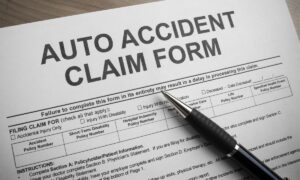 The insurance adjuster on the phone sounds so reasonable. They use a calm, professional tone as they ask you to walk them through the accident.
The insurance adjuster on the phone sounds so reasonable. They use a calm, professional tone as they ask you to walk them through the accident.
Then, the questions start to shift. “Were you in a hurry?” “How fast do you think you were going?” “Did you see the other car at all before the impact?” Suddenly, you realize this is not a conversation.
It is an interrogation. The adjuster is not trying to understand your story; they are hunting for a single word or phrase they can use to blame you for your own injuries.
This is the insurance company’s most powerful weapon, and it all comes down to Georgia’s comparative negligence rules.
Understanding how these rules affect injury claims goes a long way in defending yourself against a system designed to deny you justice.
- Georgia’s modified comparative negligence law means you can recover damages if you are 49% or less at fault for your accident.
- If you are found to be 50% or more at fault, you are legally barred from recovering any compensation. This is an absolute cutoff.
- Insurance companies aggressively exploit this rule, searching for any reason to shift a percentage of the blame onto you to reduce or eliminate their payout.
- The percentage of fault is not a matter of opinion; it is determined by hard evidence like police reports, witness testimony, and expert analysis.
- You must never admit fault or apologize after an accident, as the insurer will use these statements as proof that you are at least partially responsible.
The 50% Bar: Georgia’s All-or-Nothing Rule
To understand how your injury claim will be handled, you first need to understand the legal battlefield. Years ago, Georgia followed a harsh doctrine called “contributory negligence.”
Under that old system, if you were found to be even 1% responsible for the accident that injured you, you recovered nothing. It was a brutal rule that let clearly negligent parties walk away without paying a dime.
Thankfully, the law has evolved. Georgia now uses a system called modified comparative negligence. This system allows for a more just outcome when more than one person’s actions contribute to an incident.
Under this rule, a jury (or the lawyers in a settlement negotiation) will assign a percentage of fault to each party involved. This percentage directly impacts your financial recovery.
Your percentage of fault reduces your total compensation award. But Georgia’s system has a razor-thin edge. This is what is known as the “50% Bar Rule,” codified in O.C.G.A. § 51-12-33.
The law states that if your percentage of fault is 50% or greater, your right to recovery is eliminated. If you are 50% at fault, you get zero.
This is why insurance adjusters fight so viciously over every single percentage point.
The Insurance Company’s Blame Game Playbook
From the moment your claim is filed, the insurance adjuster assigned to your case begins a systematic process of searching for fault on your part. Their goal is not to find the objective truth.
Their goal is to find leverage to reduce their financial exposure. They are trained professionals who know exactly what to look for and what questions to ask.
Their investigation is a hunt for any action, or inaction, on your part that they can frame as negligence.
This is how they build their case against you.
- Twisting Your Words in a Recorded Statement: The adjuster will ask for a recorded statement to “get your side of the story.” This is a trap. They ask leading questions like, “So you didn’t see the other car until it was too late?” hoping you agree. They use your answers to create a narrative that you were inattentive or slow to react.
- Weaponizing an Apology: A simple, polite “I’m sorry this happened” at the accident scene will be presented as a clear admission of guilt. They will strip your words of their human context and use them as a legal confession.
- Hiring Their Own Experts: If the stakes are high, the insurer will hire an accident reconstructionist. This expert will produce a report that, surprisingly, always seems to conclude that you were speeding, failed to brake properly, or made some other error that contributed to the crash.
- Misinterpreting the Evidence: They will take any ambiguity in the police report or a witness statement and spin it in the most negative light possible for you. They will argue that your failure to honk your horn or swerve was a negligent act.
This is a deliberate, methodical strategy to shift as much blame as possible onto your shoulders. They are not trying to be fair; they are trying to win.
The Battle of Evidence: How Fault Is Truly Proven
 The percentage of fault assigned in your case will not be decided by the adjuster’s opinion or the other driver’s lies. It will be decided by the hard evidence. This is why a swift and ruthless investigation is the only way to protect yourself from unfair blame.
The percentage of fault assigned in your case will not be decided by the adjuster’s opinion or the other driver’s lies. It will be decided by the hard evidence. This is why a swift and ruthless investigation is the only way to protect yourself from unfair blame.
While the insurer is building their case against you, your legal advocate must be building an even stronger case for you. This evidence gathering is not a passive process. It requires aggressive action to preserve proof before it disappears.
- The Police Report: The official report is the starting point. It contains the officer’s diagrams, measurements, witness information, and initial citations, which are powerful indicators of fault.
- Eyewitness Testimony: Independent witnesses with no stake in the outcome are incredibly persuasive. A witness who clearly states, “I saw the truck run the red light,” can single-handedly win the battle over fault.
- “Black Box” Data: Most modern vehicles contain an Event Data Recorder (EDR). This device captures critical data in the seconds before a crash, such as speed, braking, acceleration, and steering. This data can prove you were driving safely and destroy the other driver’s claim that you were speeding.
- Surveillance Footage: Video from traffic cameras, nearby businesses, or even doorbell cameras can provide undeniable, objective proof of what really happened. This evidence can end an argument over fault instantly.
- Expert Reconstruction: Your legal team can hire its own independent accident reconstructionist. This expert will analyze the physical evidence to create a scientific, unbiased report that counters the insurance company’s hired gun and proves how the accident truly occurred.
Without this evidence, you are left in a “he said, she said” situation where an insurance company can easily create enough doubt to assign you a high percentage of fault.
Practical Steps to Protect Yourself from Unfair Blame
From the moment an accident happens, you must act to protect yourself from the inevitable blame game. Every action you take should be viewed through the lens of how an insurance company might try to twist it later.
Following these steps is not about legal strategy; it is about self-preservation in an adversarial system. These actions create a shield that can protect you from the insurance company’s attacks.
- Never admit fault. This is the golden rule. Do not apologize or say anything that could be interpreted as an admission of guilt to the other driver, witnesses, or the police.
- Stick to the facts. When you speak to the police, provide a clear, concise, and factual account of what happened. Do not guess about speeds or distances. If you do not know, say so.
- Do not give a recorded statement. You have no legal obligation to give a recorded statement to the other driver’s insurance company. Politely decline and state that all communications will go through your legal representative.
- Preserve evidence. Take photos and videos of everything at the scene. Get contact information for any witnesses. This evidence you gather yourself can be crucial.
- Stay off social media. Do not post anything about your accident, your injuries, or your activities. Investigators will find your posts and use them to argue you are not as injured as you claim or that you were somehow at fault.
By taking these disciplined steps, you limit the ammunition the insurance company has to use against you in their fight to assign you fault.
FAQ About Georgia’s Comparative Negligence Law
What happens if the police report says I was partially at fault?
A police report is a powerful piece of evidence, but it is not the final word. The officer’s opinion is based on the limited information available at a chaotic scene. A deeper investigation by your legal team can often uncover evidence that contradicts the officer’s initial conclusion and proves the other driver was far more at fault.
Does comparative negligence apply if I was just a passenger?
Generally, a passenger is considered to have 0% fault in a collision, as they have no control over either vehicle. However, an insurance company might try to argue a passenger was negligent if, for example, they did something to distract their own driver. These are rare but not impossible arguments.
What if there were no witnesses to my accident?
A lack of independent witnesses makes a case more challenging, as it can devolve into a “he said, she said” situation. This is where physical evidence, like vehicle damage, skid marks, and EDR data, becomes even more critical. A skilled expert can often reconstruct the accident and prove fault using only the physical evidence.
How does a jury actually decide on the percentages of fault?
If your case goes to trial, your attorney and the defense attorney will present all their evidence to a jury. After hearing all the testimony and arguments, the judge will instruct the jury on Georgia’s comparative negligence law. The jury will then deliberate and assign a specific percentage of fault to each party based on their collective judgment of the evidence.
What if there were multiple cars involved in my accident?
In a multi-vehicle pileup, fault can be divided among several drivers. For example, Driver A might be 60% at fault, Driver B might be 30% at fault, and you might be 10% at fault.
You could then recover damages from the insurance companies for both Driver A and Driver B, with your total recovery reduced by your 10% share of the blame.
You Need a Fighter to Win the Battle Over Blame
The insurance company is not just processing your claim but building a case against you. They are using Georgia’s comparative negligence law as a weapon to deny you the resources you need to heal.
You cannot win this fight with good intentions or by being reasonable. You are up against a powerful corporation, and you need a powerful advocate in your corner.
We were built to take on these bullies at Jamie Casino Injury Attorneys. We know their playbook, we anticipate their tactics, and we are not afraid to drop the hammer of justice on their unfair arguments. We conduct our own ruthless investigation to uncover the truth and build an ironclad case that protects you from blame.
Your fight is our fight.
Do not let an insurance company tell you that you are responsible for your own injuries.
Contact our Savannah office today at (912) 355-1500 for a free, no-obligation case review. We will listen to your story and tell you exactly how we will fight for you. You pay absolutely nothing unless we win.

